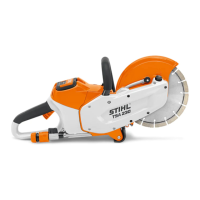TSA 230
English
18
c) When battery pack is not in use,
keep it away from other metal
objects, like paper clips, coins,
keys, nails, screws or other small
metal objects, that can make a
connection from one terminal to
another. Shorting the battery
terminals together may cause burns
or a fire.
d) Under abusive conditions, liquid
may be ejected from the battery;
avoid contact. If contact accidentally
occurs, flush with water. If liquid
contacts eyes, additionally seek
medical help. Liquid ejected from
the battery may cause irritation or
burns.
6) Service
a) Have your power tool serviced by a
qualified repair person using only
identical replacement parts. This
will ensure that the safety of the
power tool is maintained.
7) Safety instructions for abrasive
cutting-off operations
Cut-off machine safety warnings
a) The guard provided with the tool
must be securely attached to the
power tool and positioned for
maximum safety, so the least
amount of wheel is exposed
towards the operator. Position
yourself and bystanders away from
the plane of the rotating wheel. The
guard helps to protect operator from
broken wheel fragments and
accidental contact with wheel.
b) Use only bonded reinforced or
diamond cut-off wheels for your
power tool. Just because an
accessory can be attached to your
power tool, it does not assure safe
operation.
c) The rated speed of the accessory
must be at least equal to the
maximum speed marked on the
power tool. Accessories running
faster than their rated speed can
break and fly apart.
d) Wheels must be used only for
recommended applications. For
example: do not grind with the side
of cut-off wheel. Abrasive cut-off
wheels are intended for peripheral
grinding, side forces applied to
these wheels may cause them to
shatter.
e) Always use undamaged wheel
flanges that are of correct diameter
for your selected wheel. Proper
wheel flanges support the wheel
thus reducing the possibility of
wheel breakage.
f) Do not use worn down reinforced
wheels from larger power tools.
Wheels intended for a larger power
tool are not suitable for the higher
speed of a smaller tool and may
burst.
g) The outside diameter and the
thickness of your accessory must
be within the capacity rating of your
power tool. Incorrectly sized
accessories cannot be adequately
guarded or controlled.
h) The arbour size of wheels and
flanges must properly fit the spindle
of the power tool. Wheels and
flanges with arbour holes that do not
match the mounting hardware of the
power tool will run out of balance,
vibrate excessively and may cause
loss of control.
i) Do not use damaged wheels.
Before each use, inspect the wheels
for chips and cracks. If power tool or
wheel is dropped, inspect for
damage or install an undamaged
wheel. After inspecting and
installing the wheel, position
yourself and bystanders away from
the plane of the rotating wheel and
run the power tool at maximum no
load speed for one minute.
Damaged wheels will normally
break apart during this test time.
j) Wear personal protective
equipment. Depending on
application, use face shield, safety
goggles or safety glasses. As
appropriate, wear dust mask,
hearing protectors, gloves and shop
apron capable of stopping small
abrasive or workpiece fragments.
The eye protection must be capable
of stopping flying debris generated
by various operations. The dust
mask or respirator must be capable
of filtrating particles generated by
your operation. Prolonged exposure
to high intensity noise may cause
hearing loss.

